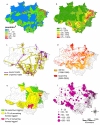Influence of deforestation, logging, and fire on malaria in the Brazilian Amazon
- PMID: 24404206
- PMCID: PMC3880339
- DOI: 10.1371/journal.pone.0085725
Influence of deforestation, logging, and fire on malaria in the Brazilian Amazon
Abstract
Malaria is a significant public health threat in the Brazilian Amazon. Previous research has shown that deforestation creates breeding sites for the main malaria vector in Brazil, Anopheles darlingi, but the influence of selective logging, forest fires, and road construction on malaria risk has not been assessed. To understand these impacts, we constructed a negative binomial model of malaria counts at the municipality level controlling for human population and social and environmental risk factors. Both paved and unpaved roadways and fire zones in a municipality increased malaria risk. Within the timber production states where 90% of deforestation has occurred, compared with areas without selective logging, municipalities where 0-7% of the remaining forests were selectively logged had the highest malaria risk (1.72, 95% CI 1.18-2.51), and areas with higher rates of selective logging had the lowest risk (0.39, 95% CI 0.23-0.67). We show that roads, forest fires, and selective logging are previously unrecognized risk factors for malaria in the Brazilian Amazon and highlight the need for regulation and monitoring of sub-canopy forest disturbance.
Conflict of interest statement
Figures


References
-
- Ferreira MU, Da Silva-Nunes M (2010) Evidence-based public health and prospects for malaria control in Brazil. J of Infect in Dev Ctries 4: 533–545. - PubMed
-
- Barat LM (2006) Four malaria success stories: how malaria burden was successfully reduced in Brazil, Eritrea, India, and Vietnam. Am J Trop Med Hyg 74: 12–16. - PubMed
-
- Marques A (1987) Human migration and the spread of malaria in Brazil. Parasitology Today 3: 166–170. - PubMed
-
- Sawyer D (1992) Malaria and the environment. Working Document 13. Interregional Meeting on Malaria, Pan American Health Organization, Brazil, April 26 to May 1.
Publication types
MeSH terms
LinkOut - more resources
Full Text Sources
Other Literature Sources
Medical

